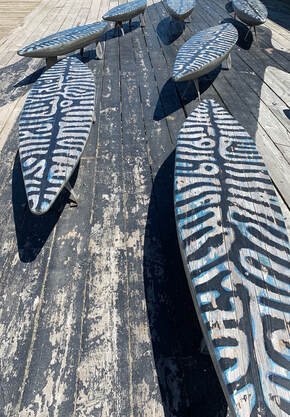Holy Mackerel!
by Kayla Hamelin
When you live in Nova Scotia, it is obvious that fishing is an important part of the culture and economy of Atlantic Canada. Fishing vessels fill our harbours. Folks head down to their local pier – rod in hand - to cast a line and see what bites. Seafood restaurants and markets abound. People fish for fun, for food, and for work.
As I begin my PhD research in fisheries science, I am gaining a greater appreciation for the wide range of species harvested off our shores. Out there under the “big blue blanket” are incredible invertebrates like the gangling snow crab, and formidable flatfish like the massive Atlantic halibut. However, there is one species that has really charmed me – the Atlantic mackerel, also known as Scomber scombrus. The more I learn about these fin-tastic friends, the more I am hooked!
Mackerel-inspired benches on the Halifax Waterfront (photo by Kayla Hamelin)
Mackerel are a marine, pelagic fish, which means that they live in the open water column of the ocean, rather than on the bottom or at the shore. They have beautiful bodies well-adapted for camouflage in the ocean, with shimmery blue on their backs, silvery undersides, and squiggly stripes down their backs and flanks. You may notice the tiny finlets (mini, nonretractable fins) on their caudal peduncle (a funky name for the area where the body meets the tail fin). These finlets help with their high-performance swimming and are a feature shared with some of the larger members of their Scombridae family, including the mighty tunas and bonitos.
Mackerel are relatively small, measuring up to about 40 cm (a bit more than a foot) in length and about 1 kg in mass. However, there is strength in numbers, and these schooling fish like to swim together in large groups to stay safe from predators. Fun fact: unlike many of their relatives, mackerel do not have a swim bladder, the gas-filled organ that helps many fish to control their buoyancy. Without a swim bladder, mackerel must follow Dory’s advice and just keep swimming!
Atlantic mackerel can be found on both sides of the Atlantic, so we share this special species with our friends in Europe. Here in North America, they range from the coast of Newfoundland and Labrador in the north all the way down to North Carolina in the south.
Mackerel always play an important role in the marine ecosystem. They are known as “forage fish” because they act as an important food source for larger animals such as marine mammals, sharks, and other larger fish. Mackerel themselves prefer to eat small invertebrates such as zooplankton. As a result, they act as an important link in the ecosystem, passing food energy up through the food web to the top marine predators. Humans like to catch mackerel, too! You may be familiar with mackerel if you enjoy fishing as a hobby. Since they spend time in our coastal waters during the summer and early fall, they are a popular catch (and meal!) for recreational fishers from around Atlantic Canada.
Photo by: Jacek Lesniowski
Unfortunately, Fisheries and Oceans Canada has classified mackerel in the critical zone, meaning that the stock has declined and needs rebuilding. However, we still don’t know a lot about the biology, ecology, and fishery operations for Atlantic mackerel. I think this seems like a great oppor-tuna-ty for fishers, scientists, and government officials to unite and work together to ensure that an abundance of these creatures can be found swimming our seas for years to come. If you’re interested in chatting all things mackerel, feel free to reach out at kayla.hamelin@dal.ca!
Kayla Hamelin is a marine researcher and educator based in Halifax. She is excited to contribute to the Back to the Sea Society by sharing information and sparking conversation about her favourite organisms and ecosystems. Kayla is currently pursuing a PhD in fisheries science and management at Dalhousie University. She is a passionate advocate for community-led stewardship and interdisciplinary approaches to environmental problem-solving.




